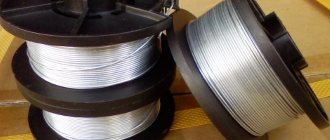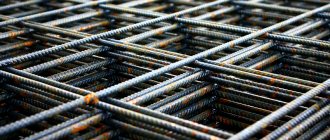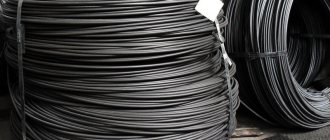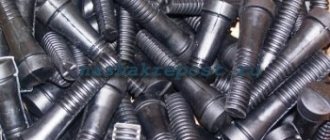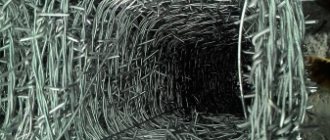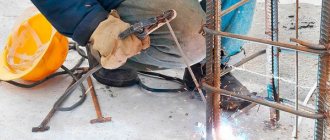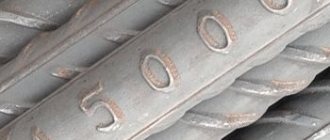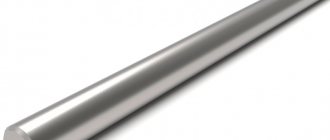In the first part of the article, we talked about whether it is profitable to buy a battery-powered knitting gun, how to make a homemade hook for tying reinforcement, and how to knit it correctly. Let's continue the topic we started. Today we will answer the following questions:
- Is it possible to tie the reinforcement together with plastic ties and a screwdriver?
- How to calculate the required amount of tying wire.
- How to bring long reinforcement to the site in a regular GAZelle.
- Is welding of fittings allowed with a welding inverter?
Characteristics of welding wire: what is affected by the type of surface and rigidity of such a product
The hardness of the wire depends on its chemical composition. When working using semi-automatic welding technology, thin wires up to 2 mm thick are used. They are supplied to the open area from special cassettes using flexible hoses up to 6 meters long. At the same time, soft wire is transmitted rather poorly through the hoses, and also does not provide proper contact with the conductive tip. At the same time, too stiff springy wires can get tangled when used inside cassettes.
Thus, the best option is to use medium-hard wire. To measure rigidity, the tensile strength indicator is used (measured in kgf/mm2). The best characteristics when welding in a carbon dioxide environment are provided by steel products with indicators of 90-140 kgf/mm2. The range in this case should be selected based on the thickness of the wire, which can vary from 0.3 to 2 mm. The larger the diameter, the more tensile strength should be closer to 90 kgf/mm2.
The quality of the work performed is largely influenced by the surface of the electrode wire. In this regard, leading manufacturers of welding equipment and consumables produce wire in special protective and completely sealed packaging. Most often it is sold in cassettes intended for use in semi-automatic and automatic welding machines. The surface of the product is cleaned of lubricants and any other substances that could adversely affect the properties of the metal compound.
In conclusion, we note that welding wire is a very important component of the welding process, which can affect the quality and durability of the connection, and therefore you should be extremely responsible and methodical in choosing the composition and thickness of the wire.
What chemical elements are included in the composition of welding wire as deoxidizing elements?
There are a huge variety of models of welding wire designed to work in shielding gases, differing in the presence and ratio of the content of various deoxidizers. Among the main elements of such a plan are:
- Carbon . An increased amount of carbon promotes boiling of the metal when operating at high temperatures, and also reduces the likelihood of pores occurring inside the weld due to hydrogen and nitrogen content. However, carbon content above 0.12-0.14% may cause hot cracking.
Thus, it is advisable to use 0.06-0.12% carbon in the case of welding low-carbon alloy steels;
- Manganese . By itself, this chemical element has a fairly low deoxidizing ability, but it can enhance the effect of other deoxidizing elements, primarily aluminum and silicon.
Thus, for welding low-carbon and low-alloy steels in a CO2 environment, the following ratio of elements should be used: 0.05-0.12% C, 0.6-1% Si, 1.4-2.4 Mn;
- Silicon . Silicon must be contained in the metal weld in an amount of at least 0.2% to prevent the appearance of pores caused by exposure to carbon monoxide. At the same time, a high content of this element (more than 0.45%) can increase the likelihood of hot cracks;
- Aluminum . This element is a strong, energetic deoxidizer. It can not only ensure the absence of pores that appear when exposed to nitrogen and carbon monoxide, but also act as a structure modifier that increases the mechanical characteristics of the metal alloy. But in too large quantities, aluminum can reduce the metal's ductility, reduce toughness, and promote hot cracking;
- Titan . Reduces the likelihood of pores while providing a more stable welding arc when using the straight polarity welding method. This element also helps remove deoxidation products from the alloy and somewhat reduces the level of spattering;
- Zirconium . Helps increase the impact strength of the seam in a carbon dioxide environment at low temperatures, and also protects against the formation of pores. The use of wire with zirconium when welding with straight polarity increases the productivity of surfacing and protects thin metal from burn-through.
- Calcium . The peculiarity of this element is that it has a low boiling point and is sparingly soluble in iron. For this reason, adding it to a steel alloy in the strictly required volume is a rather difficult task. However, calcium in a vapor state is capable of reacting with the liquid steel alloy, resulting in a special type of non-metallic compound. At the same time, the impact strength of the metal increases and the metal structure of the weld changes.
Types of knitting wire and areas of use
Products differ in the method of heat treatment into light and dark. They have standard characteristics, but differ in application features. Wire that has been annealed in furnaces with an inert gas environment has a clean surface without traces of scale. It is marked with the letter “C” and is highly decorative. You can work with it without gloves. Dark products are obtained by annealing in air. They are less expensive, but the rental leaves traces of scale. To avoid staining your hands and other objects, you need to work with the wire carefully while wearing gloves. Wire is available with and without coating. On sale you can find products in skeins or coils. Products used to bind reinforcement cages are often sold in sections. They are completely ready to use thanks to the presence of rings around the edges.
Zinc is usually used as a decorative and protective coating. Manufacturers use various galvanizing technologies: cold, galvanic and hot. The latter involves immersing the wire in a bath of liquid metal. It forms a thick and durable layer on products. The products are durable, but have low environmental friendliness. It is not used for interior work. The galvanic technique is characterized by the formation of a less thick coating. Cold technology is used to process small areas. Here, compositions with a very high zinc content are used, reaching 96%.
There is a special type of product with an additional polymer coating. Such a knitting wire is obtained through the process of applying powder dye and subsequent polymerization. Products are available in different shades. Their main area of application is weaving fencing structures and decorative gabions for landscape design.
How to make a homemade hook for tying reinforcement
So:
1. You can make a hook yourself or buy a ready-made one. The asking price is 150-200 rubles. Advantages of a purchased one: the steel “body” of the hook rotates freely in the handle, which significantly speeds up the work.
There are models of hooks with bearings, but they are much more expensive than a regular hook with a sleeve.
The advantages of a homemade hook are that you can make it in 10-15 minutes from what you have on hand. For example, a hook for tying reinforcement is made from a “150” nail, an electrode, reinforcement with a diameter of 8 mm, a paint roller holder from which the roller is sawed off, a trowel handle, etc.
There are many options. It all depends on imagination and the presence of “unnecessary” things lying around the household.
Freedom-VUser FORUMHOUSE
I made a homemade hook for tying reinforcement from a steel bar. I ground one end into a cone on a sharpener and bent the rod in two places. Instead of a handle, you can put a piece of tube, it’s more convenient to work, and the glove doesn’t get wrapped around the device.
Another version of a homemade hook is offered by a portal member with the nickname alexdomm. To do this, take an old fork (if, of course, you have one on the farm) and cut off one pin. Next, we take a pipe with a diameter of 16 mm, drive a pin into it and rivet/weld the end. We sharpen the working part on an emery wheel or using a grinder.
Because For the manufacture of forks, hardened steel is used; with such a hook you can twist the “three” wire, and the hook will not straighten out.
SpehFirst used a paint roller to make a homemade hook, from which he cut off everything “unnecessary”.
Another option is to make a hook from a broken or unnecessary trowel.
The principle is the same - we break off or cut off the blade and grind the working part of the hook into a cone.
alex30rusFORUMHOUSE user
I made the hook from smooth figure eight reinforcement. In order for the hook to be quickly removed from the loop, be sure to sharpen it to a cone. We bend the “body” of the hook at an angle of 20 degrees. This increases the rotation speed. For convenience, you can put a piece of hose on the handle.
WIRE OK - PRICE PER KG
If you need wire ok, you can buy it in Moscow at. The catalog presents products from the leaders of the Russian specialized market - the Ural Precision Alloys Plant (NLMK Group), as well as the Beloretsk Metallurgical Plant). The products are of exemplary quality and comply with GOST 3282-74, while the cost of the product is quite affordable - it is presented in the catalog.
Available - annealed and unannealed wire, galvanized and uncoated. The products are supplied in skeins (one piece) and bundles (no more than three pieces per winding). Depending on the diameter and the presence of a zinc surface, the weight of coils and coils can vary from 1 kg (uncoated) and 0.3 kg (coated) to 40 and 10 kg, respectively, the permissible maximum weight of coils can be up to 500 - 1500 kg.
We deliver products by road throughout the capital, as well as by road or rail transport throughout Russia. You can find out more about prices for OK wire and other products, as well as delivery conditions, by calling: (495)363-38-10;.
